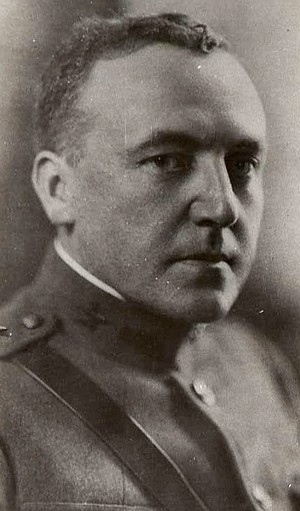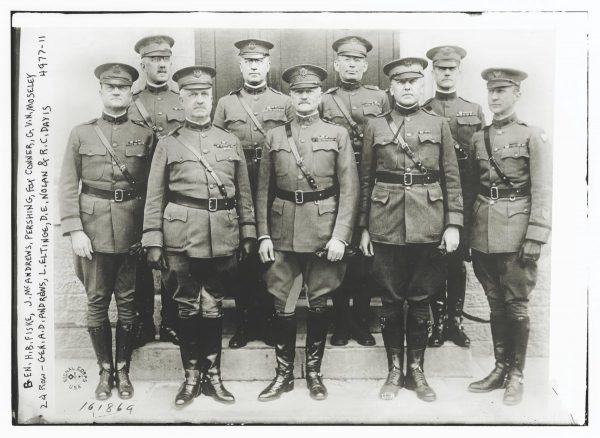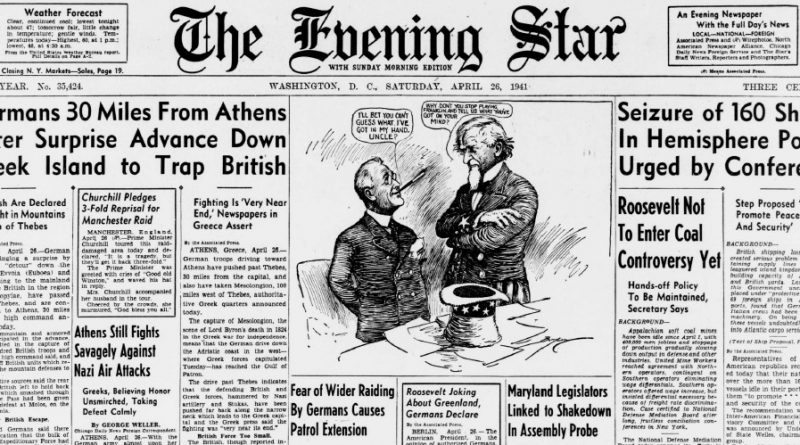World War II Chronicle: April 26, 1941
Click here for TODAY’S NEWSPAPER
Maj. Gen. Fox Conner, Gen. John J. Pershing’s operations officer (G-3) during the First World War, addresses concerns that Nazi Germany’s victory in Greece could spell defeat of the British Empire (see page five). Conner states that the Allies faced tighter spots than this during the World War I and that Greece — while a setback to be sure — was merely a “sideshow.”

The son of a many-times-wounded Confederate soldier would mentor several junior officers who became some of the highest ranking officers in United States Army. He had befriended George Patton in 1913 and the two officers accompanied Pershing to Europe as part of the advance element of the American Expeditionary Force (AEF). Conner was like a big brother for Patton, and kept the talented officer’s personality from getting him in too much trouble. Patton was Conner’s G-2 (intelligence officer) and G-3 when Conner ran the Hawaiian Department after World War I.
In 1920, Patton introduced his friend Dwight Eisenhower to Conner at a dinner, who quickly took the Ike under his wing and requested he be assigned to his staff during duty in Panama. Eisenhower learned a great deal from Conner, for whom he had tremendous respect and considered to be a father figure.
Lt. Col. George Marshall served as 1st Infantry Division’s G-3, planning and coordinating the attack at Cantigny. America’s first offensive of the war was a success and Conner had Marshall transferred to AEF headquarters as his assistant. Conner had immense respect for Marshall and considered him a genius. When Conner’s former West Point classmate Malin Craig was retiring, he petitioned heavily for his former protégé to become the new Army Chief of Staff.
When Craig was a student at the Army War College, Conner was his instructor. Craig was partnered with Lt. Col. Hunter Liggett during class 1both later became presidents of the War College during exercises, and when Liggett was picked to command the 41st Infantry Division — and later, I Corps — he selected Craig as his chief of staff. Going back to 1914, Liggett and his aide-de-camp, Capt. George Marshall, rode through the Philippines and determined that an enemy invasion of the Lingayen Gulf would be virtually unstoppable without increased U.S. military and naval resources. Unfortunately, we will soon see that his advice went unheeded.
Craig was so impressed with Patton’s submitted plan for tank operations for the Meuse-Argonne campaign that he sent copies to all of I Corps’ division commanders. Patton was likewise affected by Craig’s running of the Cavalry School, having graduated in 1923, that he wrote a recommendation to Gen. Pershing — then Chief of Staff — that Craig be chosen as chief of cavalry. Pershing wrote back that he would likely choose Craig for the post. Craig and Deputy Chief of Staff Conner teamed up to advocate for Patton as Commandant of Cadets at West Point, and Craig nominated George Marshall for his first star. Once Craig was Chief of Staff, he moved Marshall to the War Plans Division and soon thereafter named Marshall his deputy.

During his career Craig fought against the calcified post-World War military. One effort was to change infantry divisions from a “square” formation of four regiments apiece to a smaller and more maneuverable “triangle” division with three regiments. As Chief of Staff, Craig appointed a panel of Maj. Gen. Conner, Brig. Gen. Marshall, and Brig. Gen. Lesley J. McNair (Marshall’s roommate on the troopship when the 1st Division sailed to Europe) to recommend changes to the divisional structure. Marshall formalizes the modification to triangular divisions just days after taking office. Craig also ordered the military to review its war plans against possible enemies, which had been in place for decades. We may shake our heads at how poorly prepared the French military was following World War I and how easily the Germans overcame them in 1940. Nations always prepare for the last war, right? But were it not for officers like General Craig who challenged the establishment, we may have been as inept as the French.
Conner wasn’t done imparting wisdom to officers when he retired: you have probably heard his guidelines for democratic nations at war:
- Never fight unless you have to
- Never fight alone
- Never fight for long
Speaking of Patton and Marshall: the Virginia Military Institute (VMI) graduate finished fourth in the modern pentathlon during the 1912 Olympics and his sister Anne was briefly engaged to Gen. Pershing. Marshall also attended VMI, where he was an All-Southern tackle for the football team.
Evening star. (Washington, D.C.), 26 April 1941. Chronicling America: Historic American Newspapers. Lib. of Congress.
https://chroniclingamerica.loc.gov/lccn/sn83045462/1941-04-26/ed-1/
